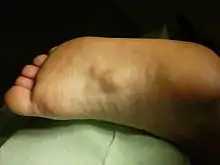Morbus Ledderhose
Morbus Ledderhose ist eine erstmals 1894 vom deutschen Chirurgen Georg Ledderhose beschriebene,[1] gutartige und teilweise schmerzhafte Bindegewebseinlagerung an der Fußsohle (Plantar-Aponeurose) aus der Gruppe der Fibromatosen (siehe auch Morbus Dupuytren). Ein schubweiser, über mehrere Jahre dauernder Krankheitsverlauf ist typisch.
| Klassifikation nach ICD-10 | |
|---|---|
| M72.2 | Fibromatose der Plantarfaszie (Ledderhose-Kontraktur) |
| ICD-10 online (WHO-Version 2019) | |
Bei Morbus Ledderhose bilden sich in der unter der Sohlenhaut liegenden Plantaraponeurose Knoten und gelegentlich auch Stränge. Die Knoten können wesentlich größer werden als bei Morbus Dupuytren und die Gehfähigkeit schließlich beeinträchtigen. Die Erkrankung kann u. a. als Nebenwirkung von Barbiturat-Antiepileptika wie Phenobarbital,[2][3] oder Primidon[4] aber auch anderen Medikamenten[5] vorkommen.
Die Operation des Morbus Ledderhose ist problematisch, weil die Füße im Alltag stark belastet werden. Kasuistisch wurde eine rasche Besserung nach Entfernung der betroffenen Faszien berichtet.[6] Gute Erfolge – vor allem im frühen Stadium – zeigt die Behandlung mit weichen Röntgenstrahlen.[7] Es gibt auch Versuche mit Stoßwellentherapien[8] und der Injektion von Kollagenase,[9] die die Verhärtungen anlöst. Die Fibrosenperforation, die die Wucherung nicht beseitigt, aber die Kontraktion – zumindest für einige Zeit – löst, spielt bei Morbus Ledderhose eine geringere Rolle als bei Morbus Dupuytren, weil bei Morbus Ledderhose im Allgemeinen die Zehen nicht kontrahieren.


Weblinks
Einzelnachweise
- Georg Ledderhose: Ueber Zerreissungen der Plantarfascie. In: Langenbecks Archiv für klinische Chirurgie. Band 48, 1894, S. 853–856.
- D. Schmidt, G. Beck-Mannagetta, H. Sörensen: Plantar fibroma associated with phenobarbital treatment. In: J. Oxley, D. Janz, H. Meinardi (Hrsg.): Chronic Toxicity of Antiepileptic Drugs. Raven Press, New York 1983, S. 133–145.
- A. Strzelczyk, H. Vogt, H. M. Hamer, G. Krämer: Continuous phenobarbital treatment leads to recurrent plantar fibromatosis. In: Epilepsia. Band 49, 2008, S. 1965–1968.
- W. Fröscher, F. Hoffmann: Dupuytren’s contracture in patients with epilepsy: follow-up study. In: J. Oxley, D. Janz, H. Meinardi (Hrsg.): Chronic Toxicity of Antiepileptic Drugs. Raven Press, New York 1983, S. 147–153.
- V. Vandersleyen, M. Grosber, S. Wilgenhof, J. De Kock, B. Neyns, J. Gutermuth: Vemurafenib-associated Dupuytren- and Ledderhose palmoplantar fibromatosis in metastatic melanoma patients. In: J Eur Acad Dermatol Venereol. Band 30, Nr. 7, 2016, S. 1133–1135.
- B. G. Souza, G. Z. de Souza Júnior, R. M. Rodrigues, D. S. Dias, V. M. de Oliveira: Surgical Treatment of a Case of Ledderhose's Disease: A Safe Plantar Approach to Subtotal Fasciectomy. In: Case Rep Orthop. Band 2015, 2015, S. 509732.
- S. Grenfell, M. Borg: Radiotherapy in fascial fibromatosis: a case series, literature review and considerations for treatment of early-stage disease. In: J Med Imaging Radiat Oncol. Band 58, Nr. 5, 2014, S. 641–647.
- K. Knobloch, P. M. Vogt: High-energy focussed extracorporeal shockwave therapy reduces pain in plantar fibromatosis (Ledderhose's disease). In: BMC Res Notes. Band 5, 2012, S. 542.
- Z. S. Hammoudeh: Collagenase Clostridium histolyticum injection for plantar fibromatosis (Ledderhose disease). In: Plast Reconstr Surg. Band 134, Nr. 3, 2014, S. 497e-498e.